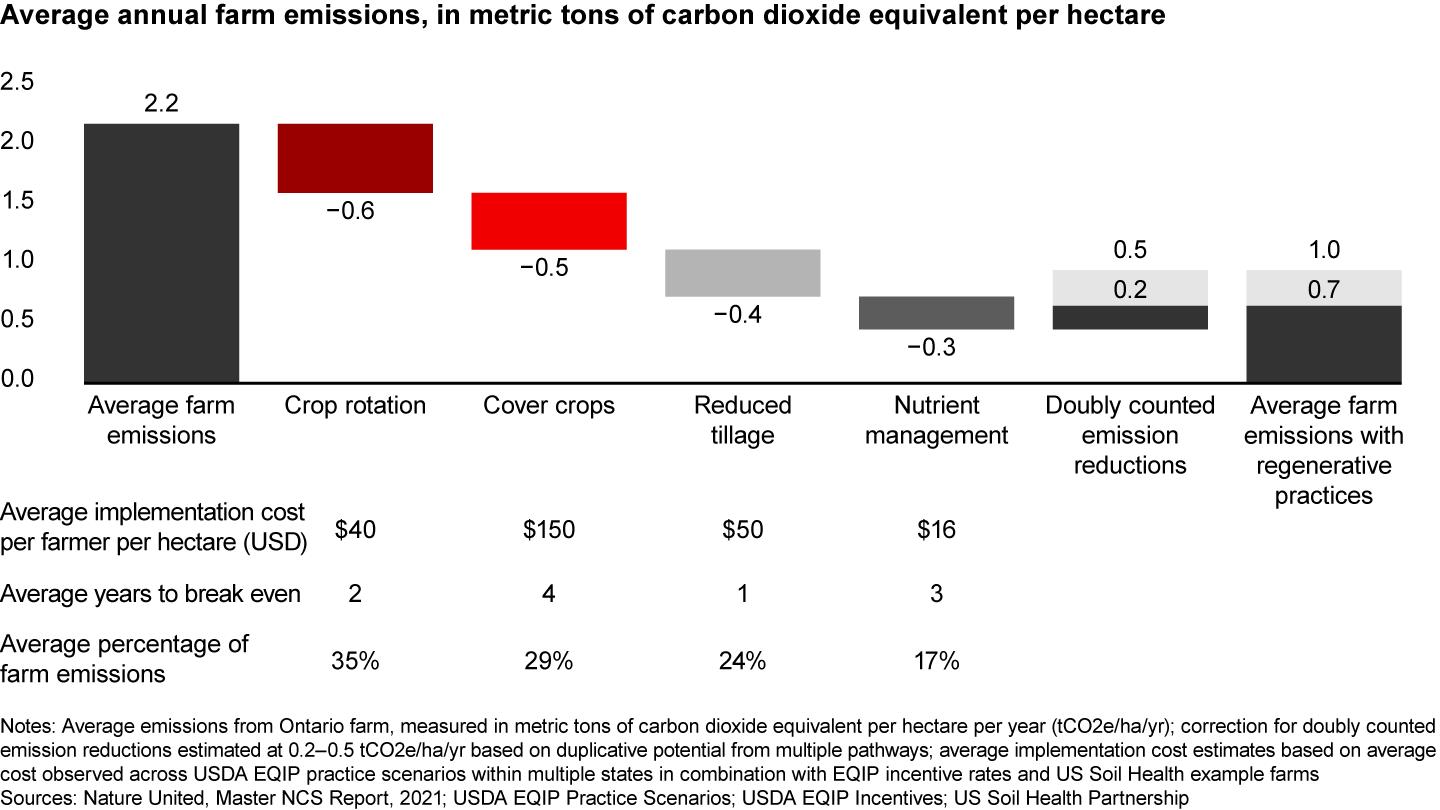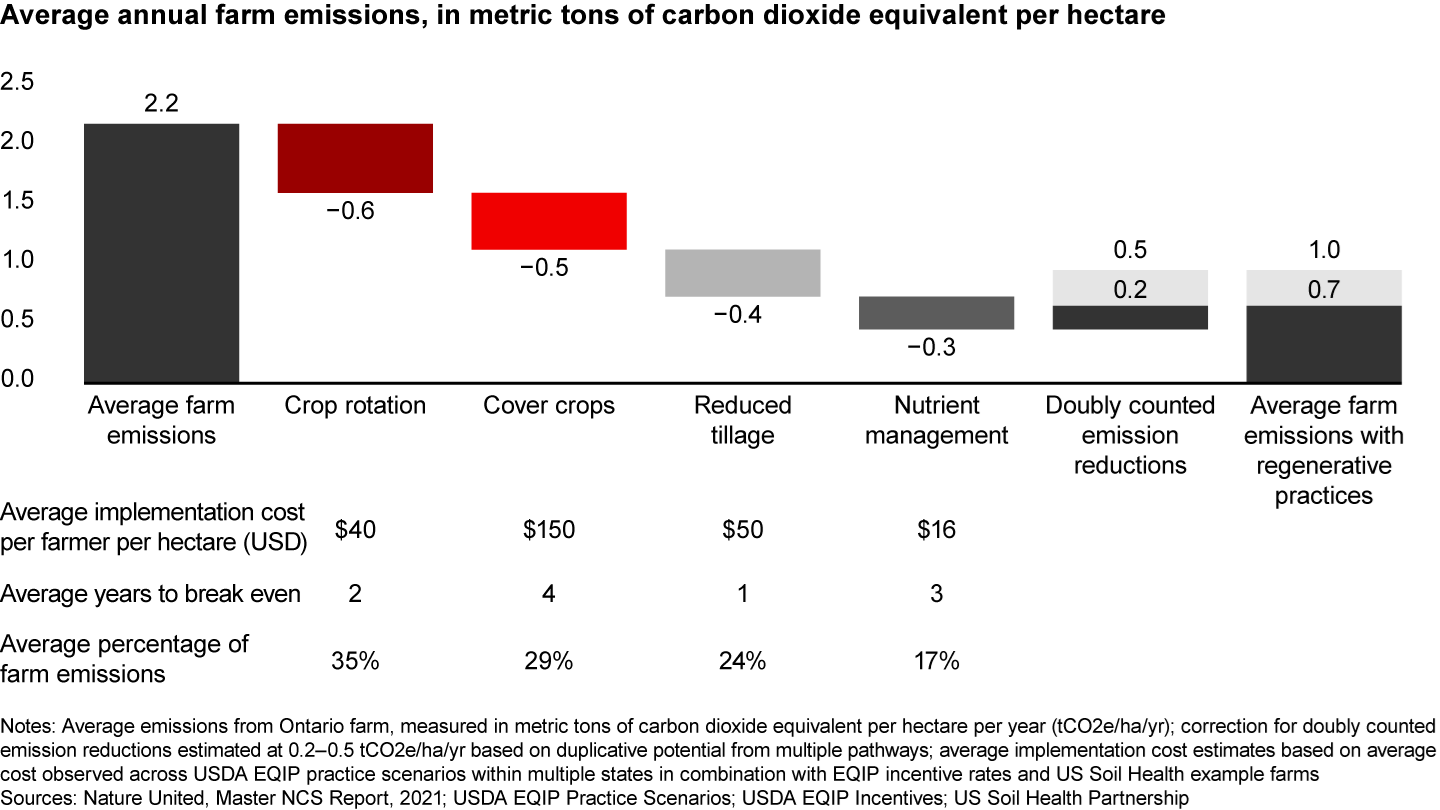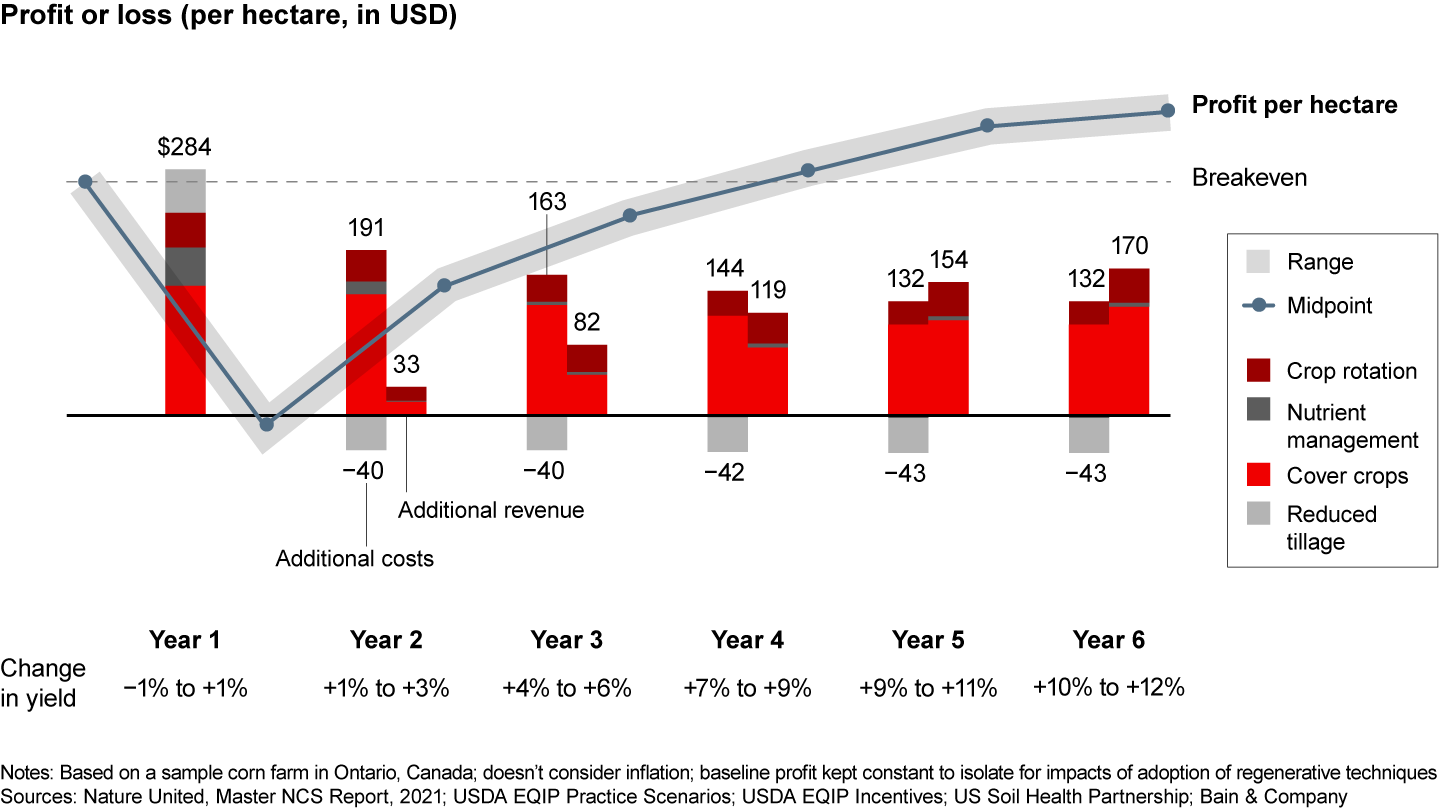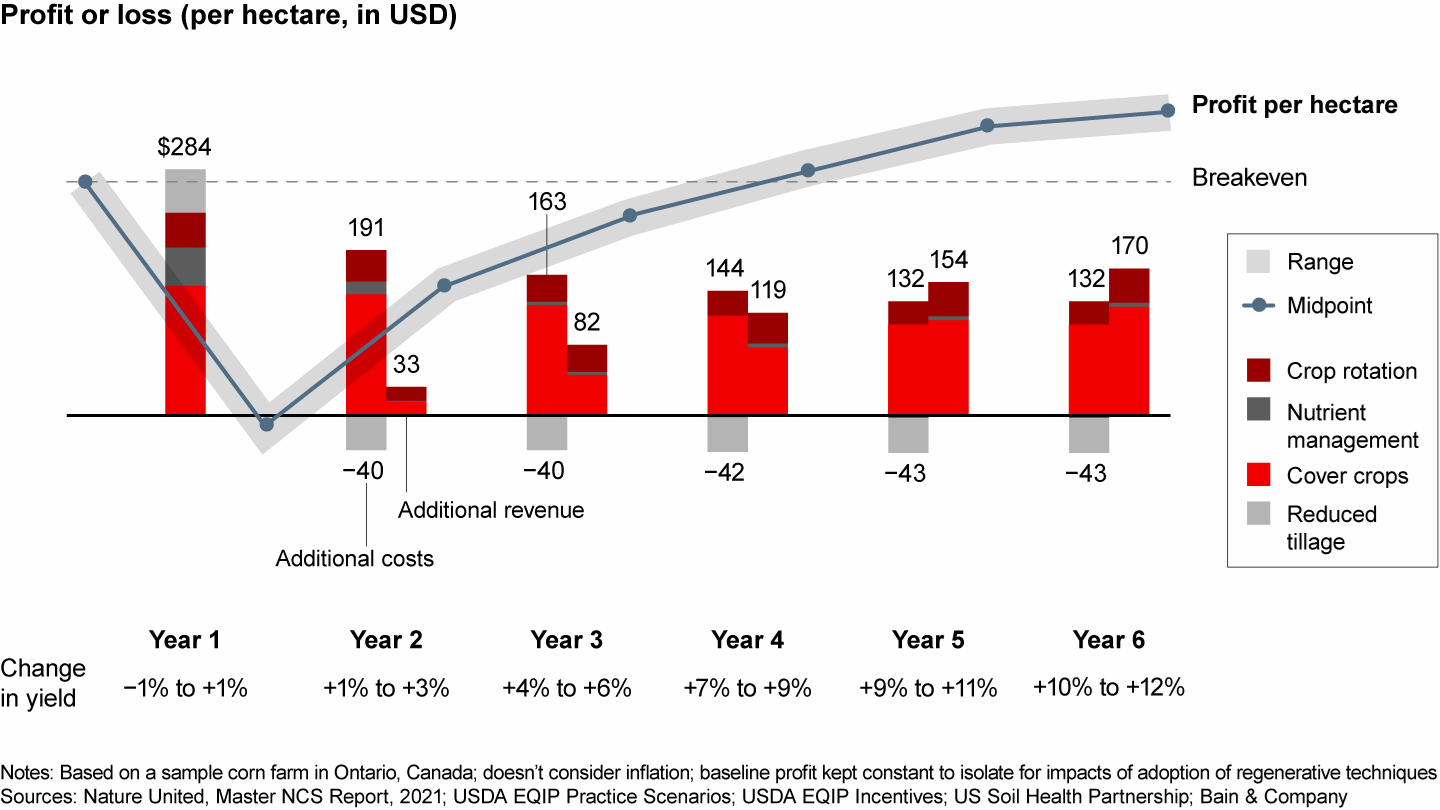Brief

Regenerative agriculture—namely, a set of practices that promote healthier soil and fewer negative effects on the ecosystem—is gaining attention as a way to help countries reduce emissions, sequester carbon, and improve the economics of farming. Globally, agriculture and waste represent about 15% of greenhouse gas emissions, so reducing that impact will be essential to meet the net zero goals of countries over the next few decades.
Only a small percentage of farmers deploy some (or all) of the main components of regenerative agriculture today. To have a meaningful effect on reducing emissions, many more farmers will need to adopt regenerative principles. One thing working against widespread adoption is the perception that regenerative agriculture is something for small-scale, organic, or heirloom farms. But a recent, peer-reviewed natural climate solutions (NCS) study by Nature United and 16 research partners in Canada has shown outsized potential in regenerative agriculture. The study examined how protecting, managing, and restoring nature can help contain the climate crisis. Combined with business analysis by Bain & Company primarily on farms in Ontario, Canada, these studies suggest that regenerative agriculture could be deployed over millions of hectares of croplands on large farms with major crops such as corn, wheat, and soy. Once in place and running at scale, the effects would benefit not only the environment but also, in many cases, they should improve the yields and the economics of those farms (see Figure 1).


Early studies on the economics of regenerative agriculture show that farmers using these techniques can increase their profit margins by as much as 30%—but not right away. Farmers typically experience some yield loss during the first two seasons as they learn new techniques and the soil is reconditioned. They may break even in the third and fourth seasons, and by the fifth or sixth season, they begin to see greater profitability (see Figure 2). Since few farmers have the resources to weather a two- to four-year dip in revenue, they will have to receive support during this transition. Farmers’ supply chain partners could invest in this type of support as part of their sustainability efforts and make progress toward their own goals for reducing scope 3 emissions.


Four elements of regenerative agriculture
Regenerative agriculture means different things in different places and depends on a wide range of factors, including climatic and soil conditions. While there are many practices that could be considered as aspects of regenerative agriculture, this brief focuses on four that tend to be recognized as generally practical, useful, and not overly disruptive to ongoing farm operations.
Cover cropping: One of the most widely known and accepted practices in regenerative agriculture is cover cropping—that is, planting crops in fields that would otherwise lay fallow between growing seasons or that can grow simultaneously with cash crops. For centuries, farmers in Europe and North America followed this practice, but it fell out of favor during the 20th century as agriculture industrialized and cover cropping wasn’t seen as economical. Encouraging farmers to bring it back by planting oat, mustard, buckwheat, alfalfa, clover, or other crops could reduce greenhouse gas emissions by between 0.5 and 1 metric ton per hectare of land each year. Cover crops put more carbon into the soil, which helps retain moisture, reduce irrigation, and strengthen crops to fight off diseases or withstand drought. Other benefits include weed control, less erosion, a reduced need for fertilizers, and up to a 10% boost in yields.
Of course, many more farmers would need to take up the practice to have an effect. In Canada, somewhere between 2% and 10% of farmers plant cover crops each season. About 20 million hectares of croplands in Canada could adopt cover crops, but several barriers lie in the way, including constraints related to soil moisture and growing season length. In northern areas, growing seasons can be short, making it difficult to establish cover crops between seasons. The additional cycle also adds complexity and costs for farmers, about US$150 per hectare in Canada. In other countries, the potential for cover cropping may be greater.
Nutrient management: More precise management of fertilizers and manure could also reduce emissions. The NCS study indicates that emissions reductions of as much as 9 megatons a year in Canada are possible by 2030. As with cover cropping, only a small percentage of farmers follow these practices today, but more could if they receive the proper training and support.
Advocates of smarter fertilizer application talk of the four Rs: the right fertilizer source, applied at the right rate, at the right time, and in the right place. The benefits extend beyond soil health to include cleaner air and water, better biodiversity in the nearby area, plus a financial upside for the farmer. When applied correctly, farmers can avoid fertilizer runoff or volatilization, thereby reducing waste, unnecessary costs, and impacts on fresh water. Better management of manure usually occurs in places where crops and animals are grown in the same area. The storage and sustainable use of manure applied as fertilizer creates a more circular economic system, reducing the amount of methane released, cutting the costs of commercial fertilizer, and improving soil quality.
Reduced tillage: Traditional tilling breaks up the soil, which can help keep weeds down but also leaves soil dried out and subject to crusting on its surface. A number of low- and no-till methods aim to make better use of the soil’s natural ability to build and retain organic material, including fungi, which may be beneficial to crops and biodiversity. The learning curve can be steep, and fields often take several years to adjust. But the resulting landscape can retain moisture and nutrients better than when fields are tilled.
Crop rotation: Crop rotation improves the health of soil, reduces erosion, and allows farmers to use less fertilizer. Centuries ago, farmers rotated crops on a three- or four-year cycle, mixing in years for grazing or laying fallow. Today’s regenerative techniques can deliver better performance by alternating between, for example, corn or wheat (which extract nitrogen from soil) and soybeans or other legumes (which restore nitrogen to the soil), supplemented by seasonal cover crops and natural fertilizers such as manure.
Supporting farmers to reduce scope 3 emissions
Agribusiness companies that maintain large networks of supplier growers may be in a strong position to support farmers through their transitions to regenerative agriculture. These companies are setting ambitious targets for emissions reductions. They will have the most control over scope 1 emissions, those resulting directly from their own operations. Scope 2 emissions could be more challenging, but they can work with their energy providers to manage and reduce their emissions from energy use. Scope 3 emissions, those resulting from upstream suppliers and downstream customers, may be the most difficult to manage but nevertheless hold considerable promise.
Supporting the farmers who supply commodities to these large companies may be one way in which the companies can make progress toward reducing these scope 3 emissions and reaching their net zero goals. Nestlé, for example, has pledged to invest US$1.3 billion over the next five years in training farmers, paying premium prices for products of regenerative agriculture, and direct investment and lending support to help suppliers through the transition period. Danone says it is supporting regenerative agriculture by providing financial and technical assistance to more than 100,000 farmers worldwide and by signing longer-term contracts that help guarantee stable revenue to farmers to help them navigate the transition.
What’s more, unlike other sustainability efforts that represent an ongoing cost—for example, a pledge to invest in bioplastic packaging—helping farmers through their transitions to regenerative agriculture is a limited-period investment that becomes self-sustaining after a few years. In fact, the transition to regenerative agriculture becomes a virtuous cycle: Improved soil organic matter resulting from these practices can, in turn, improve soil biodiversity and water utilization, which can reduce the need for (and costs of) irrigation, fertilizer, and pest management (fungicides and herbicides).
For large agriculture companies and the farmers who supply them, regenerative agriculture offers a pathway to a more sustainable food system. By investing in the transition to these techniques, companies can help lead the way to a food system that feeds the world while sustaining healthy farmlands and reducing emissions.
The authors would like to thank Deborah Froeb, Hadley Archer, and Ronnie Drever, all with Nature United, for their contributions to this work.